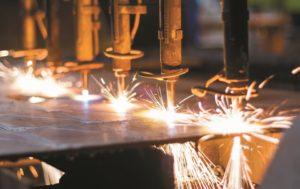MANUFACTURING’S NEW MATH: CEOs juggle complex factors in calculating where to locate tomorrow’s factories
Blog: Apriso Blog
CEOs are rethinking their global manufacturing footprints, locating plants and R&D facilities as close as possible to major customers and preparing for a new wave of technologies that could transform the shop floor. To seize the future, they must persuade their organizations to experiment at a time when risk control is paramount.
 Twenty years ago, about a dozen publicly traded industrial metal-cutting companies were headquartered in the United States. Today, Kennametal is the last survivor. While others failed, Kennametal transformed itself into the prototype of the modern global manufacturer, leveraging a world-spanning network of factories and research facilities.
Twenty years ago, about a dozen publicly traded industrial metal-cutting companies were headquartered in the United States. Today, Kennametal is the last survivor. While others failed, Kennametal transformed itself into the prototype of the modern global manufacturer, leveraging a world-spanning network of factories and research facilities.
Under the leadership of CEO Carlos Cardoso, the 75-year-old Pennsylvania-based company does business in 60 countries and achieves slightly more than half of its US$3 billion annual revenues outside the United States. “We’ve done that not by standing still in the United States, but by growing the rest of the world at a faster pace,” Cardoso said.
The key to Kennametal’s success has been to follow large customers such as General Motors as they move into new markets. By being available where its customers are doing business – North America, Europe, China and India – Kennametal avoids losing them to local suppliers who then might emerge as global competitors.
Kennametal offshored, but not for offshoring’s sake. It remains a net exporter of high-technology, high margin products.Skill Increasingly Trumps Wages
Skill increasingly trumps wages
Like other best-in-class global manufacturers, Kennametal is engaged in a relentless push toward the high end of the technology food chain. It makes drill bits that operate 30,000 feet beneath the ocean’s surface and tools to cut the complex carbon fiber panels in the Boeing 787 Dreamliner.
“There are two types of manufacturing,” Cardoso argues. “There is the low-labor-cost, high-volume, low- margin type of business that requires low skills. Those jobs are the jobs that have been mostly outsourced and offshored. Then there are high- technology, highly innovative, highly skilled, high-margin jobs. Those have tended to stay in developed economies.”
Leaders in China, a major beneficiary of offshoring, have noticed the same trend, especially as low-skill manufacturing has begun moving to countries with even cheaper labor. “We know we can’t keep relying on a low-cost competitive advantage,” Commerce Ministry spokesman Shen Danyang said in January. “We need to accelerate the value-added upgrading of our products” (see related article “China’s Challenge“).
For years, many CEOs thought China’s low wages were the answer to all their pricing challenges. Many, like Apple and Dell, outsourced the manufacturing of their most sophisticated products to third parties such as Singapore’s Flextronics and Taiwan’s Hon Hai.
Today, although factories in China remain crucial to satisfying exploding demand in the region, the value and utility of relying on factories 12 time zones away to make sophisticated products for North American and European customers is being questioned as never before.
“The equation for deciding where to locate manufacturing on either side of the Pacific Ocean is shifting,” said Willy Shih, a professor of management practice at Harvard Business School and co-author of the book Producing Prosperity: Why America Needs a Manufacturing Renaissance (see related article “Global Shift“).
The downside of offshoring
Deep structural forces help explain the shift. China’s currency has racked up double-digit gains, making it more expensive to export made-in-China goods. Labor costs are exploding by 25% to 30% a year. The Boston Consulting Group estimates that the costs of manufacturing in China will reach US levels by 2015.
In addition, long supply chains are slow to respond. Entrusted to the wrong people, important intellectual property can “leak” from companies that are not careful, and even from those that are.
Focusing exclusively on cheap labor also ignores the costs of coordinating far-flung operations and supply chains. CEOs are discovering that the feedback loops among customers, R&D and manufacturing are crucial for sustained innovation, so locating manufacturing close to R&D can be advantageous.
For example, 40% of what Kennametal sells is customized for specific end users. Six hundred Ph.D.s and engineers in nine research and development centers worldwide work to devise new materials, including tungsten carbide and industrial diamonds (see related article “Super Substances“). CEOs achieve the greatest profits and largest gains in shareholder value at this high end of the manufacturing ladder.
Continue reading the rest of this story here, on COMPASS, the 3DEXPERIENCE Magazine
Leave a Comment
You must be logged in to post a comment.







